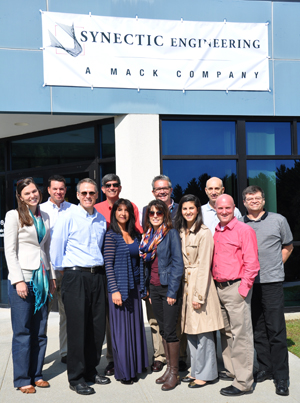 Effective today, Mack Molding is the new owner of Synectic Engineering, Inc., a medical product development company in Milford, Ct. Synectic employs 18, including mechanical, electrical, biomedical, materials, chemical and quality engineers, clinicians, and industrial designers. Facilities include 3D CAD platforms, a model shop, an in-vitro tissue lab, and an on-site Class 10,000 clean room for pilot manufacturing. Both privately owned companies, the terms of the agreement are not being disclosed.
Effective today, Mack Molding is the new owner of Synectic Engineering, Inc., a medical product development company in Milford, Ct. Synectic employs 18, including mechanical, electrical, biomedical, materials, chemical and quality engineers, clinicians, and industrial designers. Facilities include 3D CAD platforms, a model shop, an in-vitro tissue lab, and an on-site Class 10,000 clean room for pilot manufacturing. Both privately owned companies, the terms of the agreement are not being disclosed.
“This investment will allow Mack to augment its front-end services with clinically driven product development professionals that focus 100 percent of their time and talent on product design and development,” says Jeff Somple, president of Mack Molding’s Northern Operations.
“Today, OEMs want to hold fewer suppliers responsible for more,” Somple adds. “By augmenting Mack’s capabilities with engineering resources skilled in proof-of-concept, pre-clinical R&D, and product development from design to pilot manufacturing, everyone wins. Synectic gains the financial backing of a large contract manufacturer with extensive prototyping and manufacturing services. Mack adds more firepower and muscle behind its front-end services. And customers have the luxury of managing and auditing only one supplier with a robust complement of product development, molding, metal and total product manufacturing services.”
Synectic and its current employee group will remain in Milford under the supervision of its new president, Adam Lehman, who previously served as VP and chief operating officer. “We are all very excited about joining Mack, which will allow us to keep programs under one roof,” says Lehman. “We’ll now be able to provide uninterrupted oversight and support for the full life of a program, rather than handing off to a manufacturing partner. The whole process will now be seamless, because Mack will be involved from the start.”
Synectic operates on a fixed pricing model, rather than taking the more conventional time and materials approach. “Fixed fee forces a more time- and cost-conscious path,” says Lehman. “We have senior level staff, each with more than 10 years of medical product development experience, and an established process that facilitates success.” The product development process features five phases, including project definition, concept development, engineering development, design for manufacturability, and pilot manufacturing.
“There’s a gap between the genesis of a product design and its move into full production on the manufacturing floor,” says Somple, who believes these five phases will fill that gap. “It’s one thing to make one or two or 10 of something to validate a concept and function. It’s quite another to manufacture in large quantities at a competitive price in a productive fashion with good quality.
“All too often, manufacturers find themselves embroiled in concurrent engineering on design while under tremendous pressure to launch into full scale production at the same time,” he continues. “That’s really not the way to do it. This acquisition is going to strengthen our ability to bridge that gap, both for ourselves and our customers.”
Leave a Reply